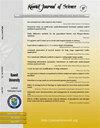改进气淬法制备钙钛矿基光伏材料
IF 1.1
4区 综合性期刊
Q3 MULTIDISCIPLINARY SCIENCES
引用次数: 0
摘要
采用不同惰性气体对气淬钙钛矿太阳能电池的制备工艺进行了分析和优化。钙钛矿光伏器件的性能和稳定性与钙钛矿结晶性能,如晶粒尺寸和晶粒间距,以及其杂质含量和缺陷密度有关。溶液处理钙钛矿层的合适形态可以通过不同的途径获得。气淬是一种有前途的、低成本的、大面积相容的钙钛矿层适当结晶的方法。在涂覆过程中,通常使用氮气冲洗钙钛矿湿膜,控制其成核阶段。到目前为止,文献中还不清楚淬火气体的分子量与钙钛矿膜形态之间是否存在任何关系。我们使用氮气、氦气和氩气作为淬火气体,分析了钙钛矿薄膜的结晶性能、晶粒尺寸、表面粗糙度和缺陷密度,以及相关的电性能和太阳能电池器件的稳定性。我们发现钙钛矿层的晶粒尺寸可以通过使用不同分子量的气体来调节。用氦气和氩气淬火的钙钛矿层具有较大的晶粒尺寸,与用较小晶粒尺寸的氮气处理的不太稳定的太阳能电池器件相比,它们在操作条件下非常稳定。本文章由计算机程序翻译,如有差异,请以英文原文为准。
Enhancing gas-quenching method for fabrication of perovskite-based photovoltaics
The fabrication of gas-quenched perovskite solar cells is analyzed and optimized by using different inert gases. The performance and the stability of the perovskite photovoltaic device are related to the perovskite crystallization properties, such as grain size and grain interspacing distance, as well as its impurity content and defect density. A suitable morphology of a solution-processed perovskite layer can be achieved by different routes. A promising, low cost, and large area compatible way of creating proper crystallization of the perovskite layer is gas quenching. Nitrogen gas is usually used for this purpose to flush the perovskite wet film during coating and control its nucleation stage. It is so far not clear in the literature if there is any relationship between the molecular weight of the quenching gas and the perovskite film morphology. We analyzed the crystallization properties, grain size, surface roughness, and defect density of the perovskite film and the related electrical performance and the stability of the solar cell devices, using nitrogen, helium, and argon as quenching gases. We found that the grain size of the perovskite layer can be tuned by using gases with different molecular weights. Perovskite layers quenched with helium and argon have bigger grain sizes and they are very stable under operational conditions compared to the less stable solar cell device processed by nitrogen gas with a smaller grain size.
求助全文
通过发布文献求助,成功后即可免费获取论文全文。
去求助
来源期刊

Kuwait Journal of Science
MULTIDISCIPLINARY SCIENCES-
CiteScore
1.60
自引率
28.60%
发文量
132
期刊介绍:
Kuwait Journal of Science (KJS) is indexed and abstracted by major publishing houses such as Chemical Abstract, Science Citation Index, Current contents, Mathematics Abstract, Micribiological Abstracts etc. KJS publishes peer-review articles in various fields of Science including Mathematics, Computer Science, Physics, Statistics, Biology, Chemistry and Earth & Environmental Sciences. In addition, it also aims to bring the results of scientific research carried out under a variety of intellectual traditions and organizations to the attention of specialized scholarly readership. As such, the publisher expects the submission of original manuscripts which contain analysis and solutions about important theoretical, empirical and normative issues.
 求助内容:
求助内容: 应助结果提醒方式:
应助结果提醒方式:


